In 2025, Software as a Service (SaaS) faces several significant challenges that developers and technical teams will need to address. One of the top concerns is data security and compliance. As data privacy regulations like GDPR and CCPA continue to evolve, SaaS providers must ensure they are compliant with these laws to protect user information. For example, a breach not only damages reputation but can also result in hefty fines. Developers will need to implement robust security measures, such as encryption and regular audits, to safeguard user data and maintain compliance.
Another challenge is managing interoperability and integration with existing systems. Businesses often use multiple platforms, and for SaaS applications to be effective, they need to integrate seamlessly with these systems. For instance, a CRM tool should easily connect with marketing automation software to provide a holistic view of customer interactions. Developers will have to prioritize building APIs and ensuring that their SaaS solutions can communicate effectively with other services, which can complicate development processes and require thorough testing.
Lastly, user experience (UX) and customer retention are critical issues. With increasing competition, users have many options for SaaS products that can fulfill their needs. Developers must focus on creating intuitive and user-friendly interfaces, minimizing onboarding friction, and ensuring reliable performance. Regularly collecting user feedback and implementing changes based on that input will be vital to staying relevant and retaining customers. This requires ongoing collaboration among development, design, and customer support teams to continuously improve the product.
